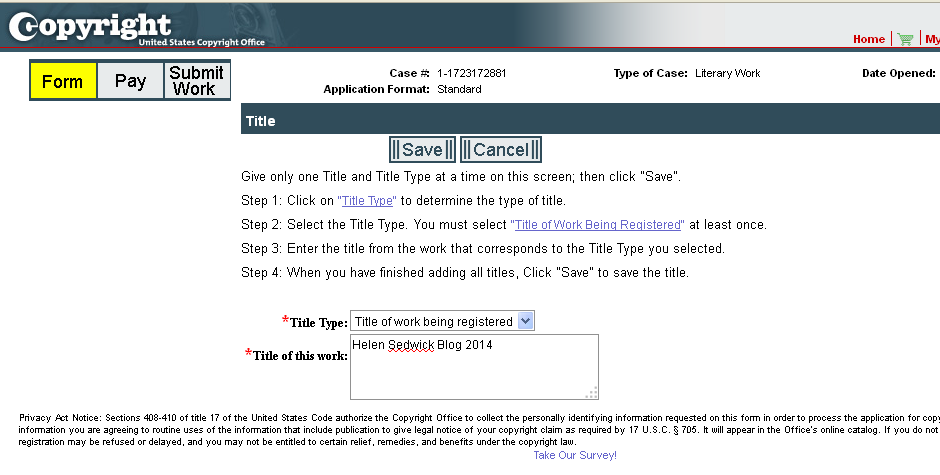Wednesday, September 17, 2014
By Helen Sedwick (
@HelenSedwick)

If someone steals your car or wallet, you know who to call for help. But what do you do when someone steals content from your website and blog?
Sooner or later, it will happen.
Content scrapers are programs that pick up RSS feeds and repost them on various sites. If you are lucky, the scraper will include your name and a link back to your blog. Often, that information is removed.
While some content theft may be unavoidable in the internet age, you should draw the line if someone steals key content, such as an excerpt of your book or the organizing concepts behind your brand. In an earlier post, I discussed the process of sending take-down notices;
Do-It-Yourself Copyright Protection. Now let?s go a few steps further.
- Put Copyright Notices on your Website and Blog
You own the copyright in your content as soon as you write it on a pad of paper or your hard drive. Yet many bloggers forget to put a copyright notice on their blog and website. Make sure your add one to each page, typically on the footer. The notice has three components:
- the copyright symbol © or the word COPYRIGHT,
- the year or years the material was created, and
- the copyright holder?s name or pseudonym.
Also add
All Rights Reserved. While not legally required, it?s a good practice, especially now that so much content is offered for free under Creative Commons licenses and labeled Some Rights Reserved or No Rights Reserved.
- Adopt Content Usage Guidelines
You want your content to be shared, not stolen. Write up Content Usage Guidelines that spell out what uses are permitted without permission, such as the number of words which may be copied, and how to give attribution and links back to your site. If you post guidelines, you are in a better position to quote them when you contact anyone who uses your work without permission.
Here are some sample content usage guidelines:
HubSpot,
InfusionSoft and
CrazyEgg.
- Register Your Web Content with the U.S. Copyright Office
If you take the added step of registering your web content and blog posts, you will be able to go after infringers for statutory damages, meaning you do not have to prove lost sales. Statutory damages are between $750 to $30,000 per work (and up to $150,000 per work if the infringement was willful). Plus, you may recover attorney?s fees and costs, making it easier to hire a lawyer on a contingency fee basis.
There are a few tricks to registering web content. Without knowing these tricks, you are likely to run into a bureaucratic brick wall.
- Trick 1: The Copyright Office Considers Web Content to be UnpublishedThis surprised me. I spent a good 45 minutes discussing it with a senior registration specialist at the Copyright Office. But as of 2014, the Copyright Office is still using a definition of ?published? that dates back to the disco era, the 1980s. To them, ?published? means the distribution of tangible material, typically printed.Obviously, this is confusing to those of us living in the 21st Century. After all, nothing is more widely distributed than web content. When you upload posts through WordPress or Blogger, you click Publish. But as far as the Copyright Office is concerned , web content is a display, not a publication.This position does not hurt you. Unpublished works get the same protection as published work. Same legal rights, same legal remedies.
- Trick 2: Register Your Posts as a Collection of Unpublished Works as a Single ClaimHere?s the benefit of calling your web content unpublished: you may register multiple blog posts under one application (and one fee) as a ?collection of unpublished work.? If you tried to register blog posts as published work, you would have to submit a separate application and fee for each post because an application may cover work published in a single day only.
I recommend you register your blog posts at the end of each year, so that all the materials in the application are created in the same year. Some lawyers recommend writers register blog posts every three months, so all posts are registered within three months following their release. That way, if a judge disagrees with the Copyright Office and decides that blogs posts are published, writers get the benefits of prompt registration. The choice is up to you; registering posts every three months is more time and money for more protection, at least theoretically.
Let?s walk through the registration process.
Click images to enlarge.In preparing to write this post, I decided to register my blog posts for 2014.
I started at the
U.S. Copyright Office online registration site and clicked
Log In to eCo. (If you do not have an account, you will have to create one. ) As a preliminary step, I had to disable my pop-up blocker.
On the next page, I clicked on
Register A New Claim (far left column) and was taken to the
Registration Process Overview page.

Since I am registering more than one blog post, I clicked ?No? for the first question. Since I am the sole creator of my blog content and have not assigned it to someone else, I clicked ?Yes? for the next two questions. I clicked
Start Registration.?
I went through a series of pages regarding the work, starting with this:

My blog is all text, with a few incidental images, so for
Type of Work at the bottom of the page, I selected
Literary Work. For more information on the different types of work, click on the shaded links.
On the next page, I inserted the title of the work. I used “Helen Sedwick Blog 2014.” Nothing fancy.

Here is the next screen. Remember for this application, your work has
not been published, so don?t be tempted into changing that to ?Yes.? I entered the year in which the blog posts were created, 2014. I did not have a preregistration number.

On the next screen, I noted what portions of the blog I had created, namely text. Some bloggers will also check photographs, artwork, etc.

On the next screen, they ask for information about the copyright claimant, me. I typed in my name, address and contact info.
Next, I was asked what portions of my blog are excluded from the registration application. You should exclude any material you did not create and any previously registered material. In my case, I excluded images since I use stock or public domain images. I also checked the
New Material Included text. If you have guest posts, click on
Other and list the excluded posts.

The next screen asks if you need special handling. You would fill this out if you were heading toward litigation and needed expedited service. I skipped it.
I went through several pages where I identified contact person, copyright holder, etc. Finally, I was sent to a payment site that is similar to many you have already seen. The fee for a collection of work is currently $55.
After payment, I was sent to the page that explains the Deposit Requirements. I clicked on
Create Shipping Slip and printed it.

Deposit Requirements
This next step is important. On the day you submit the online application, go to your online blog and
print out all the blog posts you are registering. Yes, that may be fifty or a hundred pages. If that is too voluminous, click on
Deposit Copy Requirements for alternatives.
Your printed pages must show a date
no later than the date of your application. If they show a later date, the Copyright Office may reject your application.
Mail the printed copy of your blog posts with the Shipping Slip to the address on the Shipping Slip. Since it may be 7 to 10 months before you hear from the Copyright Office, you might want to send the copy registered mail, return receipt requested. I have had a deposit lost by the copyright office, so I recommend you retain some evidence of shipping the deposit.
This process is easy. It took me more time to describe the application than it took to complete it.
I expect someday the Copyright Office will recognize their definition of published is outdated and confusing, but until then, this process should work for registering your blog posts and website content.
Remember that none of these measures stop theft. There will always be people looking to get something for nothing. But registering your web content will give you additional leverage for stopping infringement and the opportunity to recover monetary damages when it happens.
About the Author

Writer and lawyer
Helen Sedwick has thirty years of experience representing businesses and entrepreneurs as diverse as wineries, graphic designers, green toy makers, software engineers, investors, restaurateurs, and writers. Her newest release
Self-Publisher?s Legal Handbook: The Step-by-Step Guide to the Legal Issues of Self-Publishing is assisting indie author in navigating the legal minefield of self-publishing and blogging. Her historical novel Coyote Winds earned five-star reviews from ForeWord Reviews and Compulsion Reads and is an IndieBRAG Medallion Honoree. For more information about protecting your rights and your wallet, email her at
Helen@helensedwick.com or visit
http://helensedwick.com/.
Disclaimer: Helen Sedwick is an attorney licensed to practice in California only. This information is general in nature and should not be used as a substitute for the advice of an attorney authorized to practice in your jurisdiction.
Photo courtesy of Stuart Miles |
freedigitalphotos.netThe post
How to Protect Your Blog Content appeared first on
Write Nonfiction NOW!.
Nina Amir, author of How to Blog a Book and The Author Training Manual, is known as the Inspiration to Creation Coach. She moves clients from ideas to finished books to careers as authors. She teaches methods to combine passion and purpose to create products that positively and meaningfully impact the world.
A sought-after speaker as well as an author, book, blog-to-book, and results coach, some of Nina’s clients have sold 300,000+ copies of their books, landed deals with major publishing houses and created thriving businesses around their books. She writes four blogs, self-published 12 books and founded National Nonfiction Writing Month.